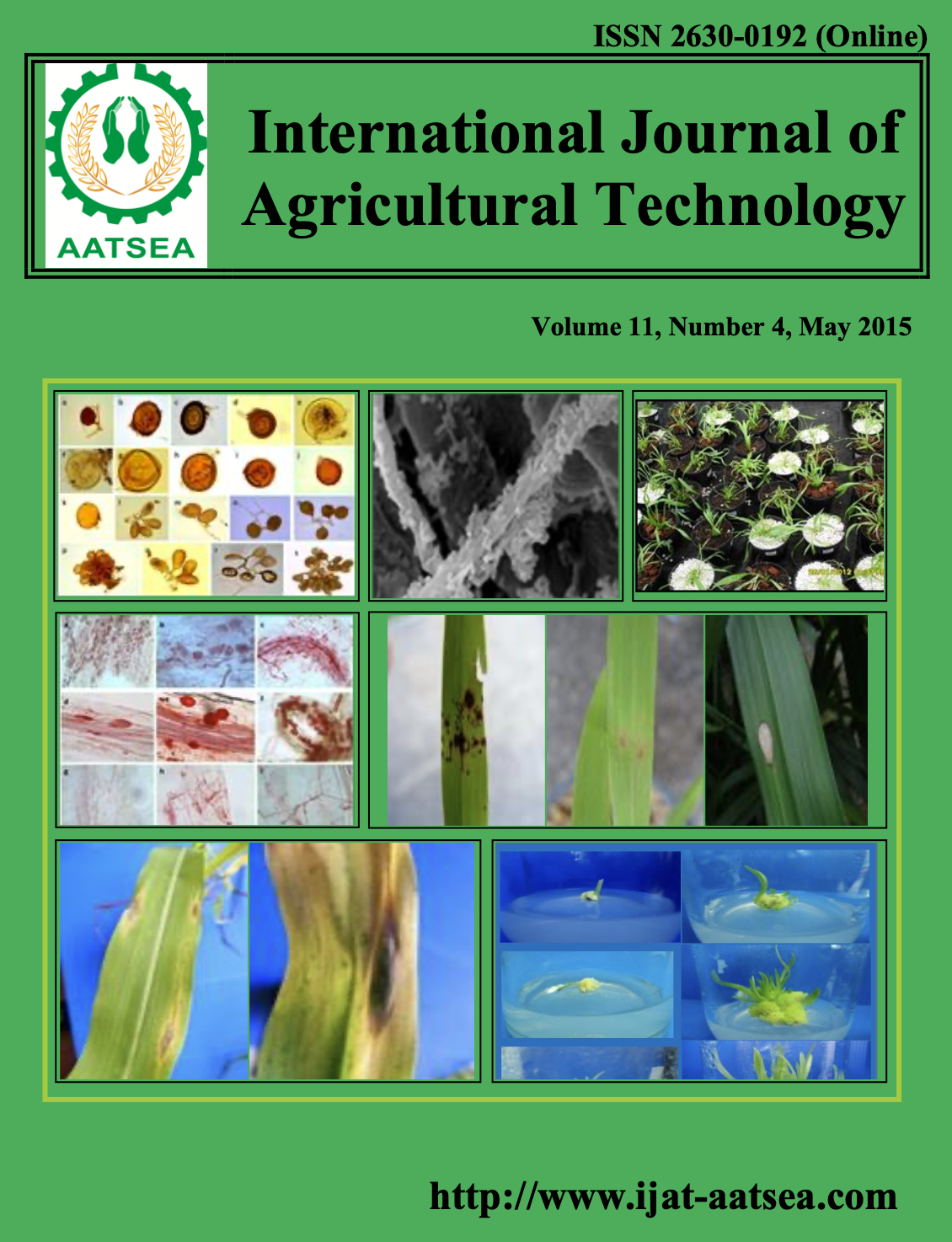Micropropagation of Lilium formolongo via leaf explants
Main Article Content
Abstract
The effect of cultured media and plant growth regulator on micropropagation from the leaf of Lilium formolongo was cultured on three basic media; Murashige and Skoog (1962) (MS), 1/2MS and Nitsch and Nitsch (1969) (NN) media in the presence and absence of plant growth regulator 1.0 mg/l a-naphthaleneacetic acid (NAA) and 0.5mg/L Thiadiazuron (TDZ). The leaf explants that were cultured on the medium without plant growth regulator died within four weeks. Callus formation was obtained from the leaf explants cultured on the medium supplemented with plant growth regulator after culturing under dark condition for four weeks. Callus cultured on the MS medium with 1.0 mg/L NAA and 0.5 mg/L TDZ gives the best average size of 2.93 centimeters. The callus was then continuously cultured on the same medium but under light condition for 16 hours/day leading to shoot development. After 14 weeks incubation, 5.05 shoots and 36.5 leaves were formed.
Article Details

This work is licensed under a Creative Commons Attribution-NonCommercial-NoDerivatives 4.0 International License.
References
Azadi, P. (2007). Micropropagation of Lilium ledebourii (Baker) Boiss as affected by plant growth regulator, sucrose concentration, harvesting season and cold treatments. Journal of Biotechnology 10:582-591.
Dimech, A. M., Cross, R. and Ford, R. (2007). Micropropagation of Gymea lily (Doryanthes excels Correa) from New South Wales, Australia. Plant Cell Tissue and Organ Culture 88:157-165.
Gupta, P., Sharma, A. K. and Charturvedi, H. C. (1978). Multiplication of Lilium longiflorum Thunb. by aseptic culture of bulb-scales and heir segments. Indian Journal of Experimental Biology 16:940-942.
Kedra, M. and Bach, A. (2005). Morphogenesis of Lilium martagon L. explants in callus culture. Acta Biologica Cracoviensia Series Botanica 47:65-73.
Murashige, T. and Skoog, F. (1962). A revised medium for rapid growth and bioassays with tobacco tissue culture. Physiologia Plantarum 15:473-497.
Nguyen, T. P. T., Nguyen, T. T. and Nguyen, Q. T. (2008). Developing an agrobacterium-mediated transformation system for Lilium formolongo using thin layer of bulb scales. Journal of Science and Development 123-128.
Nhut, D. T., Hanh, N. T. M., Tuan, P. Q., Nguyet, L. T. M., Tram, N. T. H., Chinh, N. C. Nguyen, N. H. and Vinh, D. N. (2006). Liquid culture as a positive condition to induce and enhance quality and quantity of somatic embryogenesis of Lilium longiflorum. Scientia Horticulturae 110:93-97.
Nimi, Y. (1985). Factors affecting the regeneration and growth of bulblets in bulb-scale cultures of Lilium rubellum Baker. Journal of the Japanease Society for Horticultural Science 54:82-86.
Nitsch, J. P. and Nitsch, C. (1969). Haploid plants from pollen grains. Science 163:85-87.
Ling-Fei, X., FengWang, M. and Dong, L. (2009). Plant regeneration from in vitro cultured leaves of Lanzhou lily (Lilium davidii var. unicolor). Scientia Horticulturae 199:458-461.
Ramsay, J. L., Galitz, D. S. and Lee, C. L. (2003). Basal medium and sucrose concentration influence regeneration of easter lily in overy culture. Horticultural Science 38:404-406.
Saifullah, K., Sheeba, N., Mariam, R., Naheed, K., Asma, N. and Bushra, S. (2010). Cultivation of lilies (Lilium regale) for commercialization in Pakistan. Pakistan Journal of Bottany 42:103-1113.
Xi, M., Qiu, S., Lu, Y. and Shi, J. (2013). High efficiency regeneration system of oriental lily cultivar for transgenic manipulation. Proceedings of the XIth IS on flower bulbs and herbaceous perennials. Acta Horticulturae. pp. 257-261.
Zhou, S., Rammanna, M. S., Visser, R. G. F. and van Tuyl, J. M. (2008). Analysis of the meiosis in the F1 hybrids of Longiflorum x Asiatic (LA) of lilies (Lilium) using genomic in situ hybridization. Journal of Genetic and Genomic 32:687-695.


